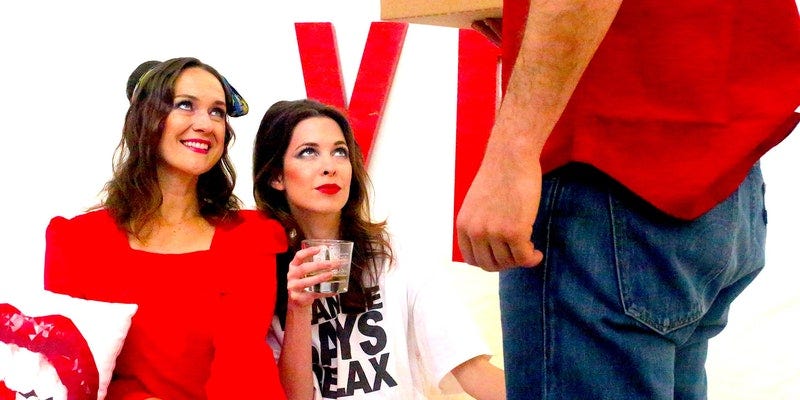
Content advisory: sexual assault.
As we entered a beautiful loft apartment in the middle of Hollywood, I have to say I was impressed with the décor. Being a site-specific piece, I was entering into a beautiful loft apartment owned by two 20-something women in the middle of 1985.
I walked up to the ticket taker and handed her my ticket. She took the tickets — then completely ignored me.
Instead, they talked directly to my girlfriend. “Feel free to explore,” they said to her.
And this become a theme throughout the night. The ushers seemed to deliberately ignore me in favor for my girlfriend. Whenever I asked a question (even as something as simple as “where is the bathroom?”) they insisted on turning to my girlfriend and directing their answer towards her.
And this was all part of the show.
Pizza Man, a show written in 1986 by Darlene Craviotto, could have just as easily been written today. It puts us headfirst into the lives of two young women in LA, and having had it with various hardships (from men to lost jobs) decide to express their anger by kidnapping and raping a pizza man. They order a pizza, the pizza man shows up, and quickly the night gets out of control.
Being put up by Pop Up Theater, these artists have been trying to reinvigorate the LA theater scene since 2014 by performing works in unconventional ways. Pizza Man is their newest form of that, taking a proscenium show and making it entirely site-specific.
Given the role reversal nature of the show, my constant neglect for preference to my girlfriend made so much sense.
Throughout the night, she was referred to as “boss” and I as “sweetie.” While my girlfriend still attests that it may have been purely coincidence, the show was all about reversing the power dynamics between men and women, why not have the audience experience a small taste of that as well?

And while the show itself was site-specific rather than immersive, it was small elements like this that allowed me to feel a deeper part of the experience. Call it a ‘meta-narrative.’ Pizza Man used the limitations of their site-specific form by employing a performative choice that could have just as easily gone ignored. Kudos to this small innovation.
And, beyond the usher to patron interactions, guests were invited to explore the space before the show. As we went upstairs, we found ourselves in the makeshift bedroom of 20-somethings, the bed and blankets thrown about in a feigned attempt to keep their room clean. We picked up a book and inside were the names and numbers of men. On the other bed, we found a pink slip crumpled and thrown away. Opening it, we discovered that this other character had just been fired.
It was a unique way to highlight the stakes to those unfamiliar with the show and give the audience a sense of discovery and adventure unique to immersive theater.
Sadly, though, the immersion stopped there. Beyond that, we took our seats and watched the entirety of Pizza Man with no more interaction.
And it was clear that their chosen space (while aesthetically awesome) was not meant for theatrical works. Many of the audience members were blocked from seeing some of the action (as some conversations were between the downstairs “living room” and the loft “bedroom”) the audience could do nothing but stare forward to reserve themselves from having to strain their necks to see far behind them.
But that didn’t hurt from the audience from enjoying the work. We laughed, jeered and cheered for the fun, tongue-in-cheek performance by Raleigh West, Emma Chandler and Freddy Giorlando, who joined the work late in the first act. As a small character study of these two women, I had the most fun watching their chemistry develop. Specifically, West’s fantastic grounded performance allowed the other two actors their individual, bombastic moments to shine.
As immersive and site-specific theatre have been notorious for gravitating towards the eerie and horrific, it was quite refreshing to see a company perform comedy. And, looking around, I couldn’t help but notice how the audience around me skewed much older.
And in that way, I think this piece was ultimately a success. For a die-hard immersive theatre buff, it left much to be desired. However, it succeeded in attracting and entertaining an older, less experienced demographic that traditionally would skew away from ‘out of this world’ performances like Sleep No More or Creep: Lore. It showed them that theatre can still be a unique, relevant, and worthwhile experience.
As we walked out that night, the ushers wished my girlfriend well while only giving me a small smirk. And in that way, that small immersion made me feel something that I hadn’t yet felt before in an immersive piece: humility.
Pizza Man is presented by Pop Up Theatre and continues a run of invitation-only performances in Los Angeles. Tickets are $25–35.
No Proscenium is a labor of love made possible by our generous Patreon backers: join them today!
In addition to the No Proscenium web site, our podcast, and our newsletters, you can find NoPro on Twitter, Facebook, YouTube, Instagram, in our Facebook community Everything Immersive, and on our Slack forum.




















Discussion